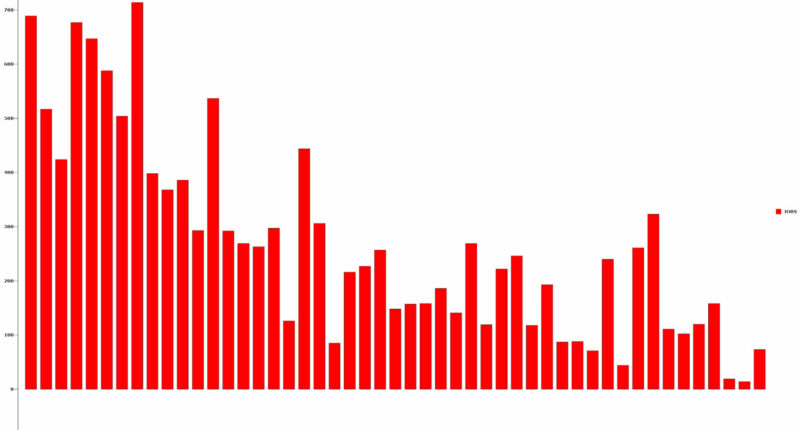Here are some bullet points from the Bureau of Labor Statistics “Employment Situation Summary” for July, released August 1, 2015.
– “This news release presents statistics from two monthly surveys. The household survey measures labor force status, including unemployment, by demographic characteristics. The establishment survey measures nonfarm employment, hours, and earnings by industry.”
Gleaned from the Household Survey Data:
– “Among the unemployed, the number of new entrants increased by 275,000 in July to 985,000. New entrants are unemployed people who are looking for their first job.”
– “The labor force participation rate, at 62.2 percent, changed little in July, but has declined by 0.5 percentage point over the year. The employment-population ratio, at 59.6 percent also changed little over the month but was down 0.4 percentage point over the year.”
Gleaned from the Establishment Survey Data:
– “Average hourly earnings for all employees on private nonfarm payrolls rose by 12 cents, or 0.3 percent, to $36.44 in July. Over the past 12 months, average hourly earnings have increased by 3.9%. In July, average hourly earnings of private-sector production and nonsupervisory employees rose by 8 cents, or 0.3 percent, to $31.34.”
– “The average workweek for all employees on private nonfarm payrolls edged up by 0.1 hour to 34.3 hours in July. In manufacturing, the average workweek held at 40.1 hours, and overtime edged down to 2.8 hours. The average workweek for production and nonsupervisory employees on private nonfarm payrolls edged up by 0.1 hour to 33.7 hours in July.”
– “Revisions for May and June were larger than normal. The change in total nonfarm payroll employment for May was revised down by 125,000, from +144,000 to +19,000, and the change for June was revised down by 133,000, from +147,000 to +14,000. With these revisions, employment in May and June combined is 258,000 lower than previously reported. (Monthly revisions result from additional reports received from businesses and government agencies since the last published estimates and from the recalculation of seasonal factors.)”
At the bottom of the Employment Situation Summary is an entry enclosed in block. In it is contained language about how establishment survey estimates are revised.
Here is language from within the block:
– “2025 Preliminary Benchmark Revision to Establishment Survey Data to be released on September 9, 2025”
– “Each year, the establishment survey estimates are benchmarked to comprehensive counts of employment from the Quarterly Census of Employment and Wages (QCEW) for the month of March. These counts are derived from state unemployment insurance (UI) tax records that nearly all employers are required to file. At 10:00 a.m. (ET) on September 9, 2025, BLS will release the preliminary estimate of the upcoming annual benchmark revision to the establishment survey data. This is the same day that the first-quarter 2025 data from QCEW will be issued.”
– “The final benchmark revision will be issued with the publication of the January 2026 Employment Situation news release in February 2026.”
Make of this what you will.
Me?
Today’s paychecks created figure of 77,000 for July is considered an “estimate” based on preliminary data. The more gullible among us consider the figure to be written in stone; it cannot be updated unless the update favors their political interests. These more gullible people are wrong in their belief, as they so often are.
What is really happening is that the estimates of paychecks added comes from data obtained by researchers who survey businesses each month on how many employees they have on payroll and on how many hours they worked. The benchmark comes from a completely different source of data, which is derived from state unemployment insurance records.
In September, the August paychecks “estimate” will issue, and the first of two revisions, i.e., updates, of the July paychecks estimate will occur, after more data from employers is received by BLS researchers.
In October, the September paychecks “estimate” will issue, and the second of two revisions, i.e., updates, of the July paychecks estimate will occur, after even more data from employers is collected by BLS researchers.
In September, the BLS will release a “preliminary estimate of the upcoming annual benchmark revision to the establishment survey data.” This means that the BLS, after receiving updated unemployment insurance data from state records, is preparing to consider adopting a final updated benchmark for the upcoming year against which revisions to monthly paychecks estimates will be measured, i.e., calculated. This means that the July paychecks estimate may once more be revised.
In February 2026, the final benchmark revision for 2025, based on state records for unemployment insurance, will be issued, which means that the July jobs estimate may be revised once again.
Let me be blunt to FlaglerLive readers. The monthly paychecks figures have always been called “estimates.” For decades, revisions to the figures have occurred in the first following month’s report and then again in the second following month’s report, when more and more employers answer surveys about their employee numbers. The figures are periodically adjusted as the benchmark is adjusted, after state unemployment insurance records are updated.
The monthly paychecks estimates have never been intended to be cast in stone.
The professional lying class that sits at the top of one of our two political parties knows these things. This explains why the professional liars are already saying the low paychecks created estimates for this month have been skewed for political purposes, even though they claimed the opposite when more favorable estimates from previous reports was claimed by them to be true.
Nothing changed in the BLS data collection and interpretation methods. The only thing that changed was the perceived necessity for the professional liars to lie about the estimates. The hope of these professional liars is that the people who so gullibly accept their other lies as truth will then launder the new lies to others.





